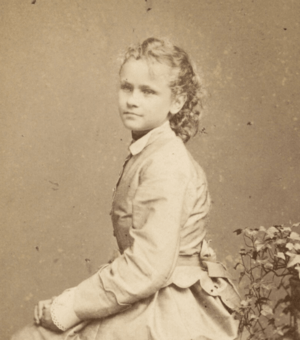Louise Wright (activist) facts for kids
Louise Gustave Dorothea Hildegard Wright (born Bauditz, 1861–1935) was an important Danish woman. She was known for helping others, fighting for women's rights, and working for peace.
From 1913, she led an organization called Præmieselskabet for Plejemødre. This group helped foster mothers and looked after more than 600 foster children. Louise Wright was also a key member of the Danske Kvinders Nationalråd, which means the National Women's Council. She even served as its vice-president.
In 1915, she helped start Danske Kvinders Fredskæde. This was the Danish part of a bigger group called the Women's International League for Peace and Freedom. She was on the board of this peace group from 1921 to 1924.
Contents
Early Life and Family Background
Louise Gustave Dorothea Hildegard Bauditz was born on January 30, 1861. Her birthplace was Fleckeby in Schleswig. Her parents were Carl Adolph Valentin Bauditz and Elisabeth Carlsen.
When Louise was three years old, her family had to move. This was because of the Second Schleswig War. They moved to Helsingør, where her father managed a home for older people. At age 15, she met Hans Beck Wright (1854–1925) at a dance. They got married in 1886.
Working to Help Others
Louise Wright was most interested in helping people. In 1913, she became the leader of Præmieselskabet for Plejemødre. This group supported working mothers. It also looked after over 600 foster children under five years old in Copenhagen. She stayed in this important role for the rest of her life.
In 1911, she joined the press committee of Danske Kvinders Nationalråd (DKN). This was a national council for women. By 1914, she was also on the board of Foreningen Mødres og Børns Bespisning. This group worked to help single mothers and their children.
Working for Peace and Unity
Louise Wright was from Southern Jutland. When World War I started in 1914, she led Flensborg-Samfundet (the Flensburg Society). She hoped that the Danish areas taken in the war would return to Denmark.
The next year, she joined Danske Kvinders Fredskæde. This was the Danish branch of the Women’s International League for Peace and Freedom. She was very active in this group. She served on its board from 1921 to 1924. Later, she became an honorary member.
After Southern Jutland became part of Denmark again in 1920, Louise Wright continued her work. As the head of the Flensburg Society, she traveled to Germany every summer. She went with Hanne Jenssen to encourage Danes living in Southern Schleswig. She also became an honorary member of Den Sydslesvigske Kvindeforening, the South Schlesvig Women's Association.
In the 1930s, Louise Wright started a women's group. This group helped raise money to build a church in Jægersborg.
Later Life
After her husband passed away in 1925, Louise Wright lived with her daughter Lissie in Jægersborg. She died in Gentofte on April 15, 1935.



